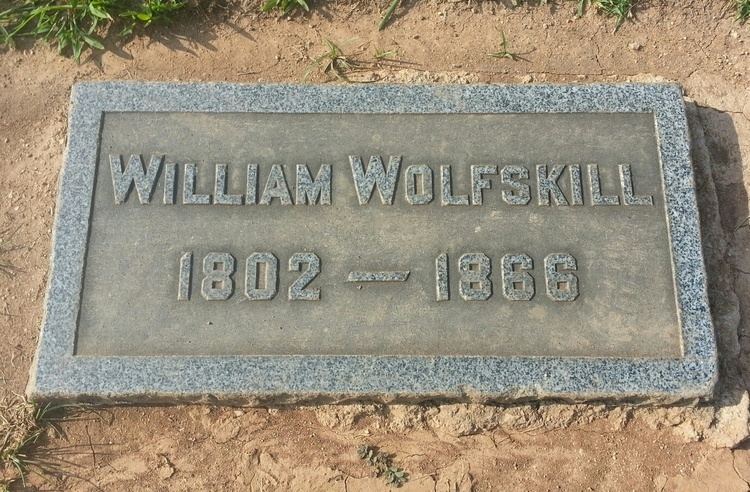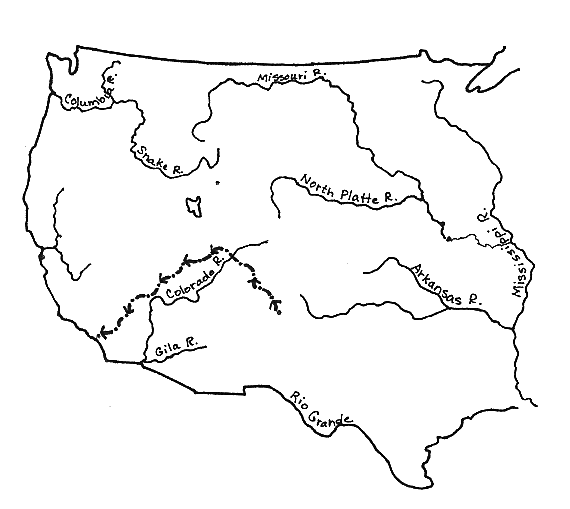Name William Wolfskill | ||
 | ||
Died 1866, California, United States | ||
Conchita Marusich on land conflict-Vaca Peña vs Wolfskill
William Wolfskill (1798–1866) was a pioneer, cowboy, agronomist in Los Angeles, California beginning in the 1830s. He had earned money for land in a decade as a fur trapper near Santa Fe, New Mexico, where he had become a Mexican citizen. This allowed him to own land in California.
Contents

Wolfskill was highly influential in the development of California's agricultural industry in the 19th century, establishing an expanded viticulture and becoming the largest wine producer in the region. One of the wealthiest men for his time, he expanded his holdings, running sheep and cultivating oranges, lemons and other crops. He is credited with establishing the state's citrus industry and developing the Valencia orange. It became the most popular juice orange in the United States and was the origin of the name of Valencia, California.
With his brother John Reid Wolfskill, in 1842 William bought a large parcel in the Sacramento Valley; they called this Rancho Rio de los Putos, later known as the Wolfskill Ranch. The brothers later divided this land, near what is now Winters, California, where John Wolfskill established orchards and vineyards. Three other Wolfskill brothers migrated to California, working first with John in the north.

History

Wolfskill moved to New Mexico in 1821, while the region was a province of Mexico called Santa Fe de Nuevo México. He spent ten years fur trapping in the New Mexico area, as the fur trade was highly lucrative. In 1828 he became a naturalized Mexican citizen.
Wolfskill left Taos, New Mexico, in September 1830 with a party of mountain men that included George C. Yount. When they arrived in Southern California in early 1831 (using the trail Smith had mapped across the Mojave desert), Wolfskill and Yount went to the coast to hunt sea otter. Wolfskill eventually returned to Southern California while Yount decided to go north, and the two parted company. Yount settled in the Napa Valley.
As a naturalized citizen of Mexico, Wolfskill was allowed to own land and acquired a parcel where downtown Los Angeles now stands. He began to cultivate grapevines for wine. He eventually planted 32,000 vines on a 48-acre vineyard. Initially, he planted mission vines, which had been introduced by the Spanish missionaries. He expanded his plantings to include other varietals later.
With his brother John Reid Wolfskill, who came to California later, he bought a large parcel in the Sacramento Valley, which John called Ranch del Rio de los Putos after a nearby creek. It was later known as the Wolfskill Ranch. The brothers later divided this land, near what is now Winters, California in the Sacramento Valley, where John Wolfskill established orchards and vineyards. Three younger Wolfskill brothers, Milton, Mathus, and Satchal, also migrated to that region, settling and working with John.
By his death in 1866, William Wolfskill was producing 50,000 gallons of wine a year. He was, by far, the greatest producer of table grapes in California during the Mexican era. He has been ranked by historians as one of the three most important men in the history of California viticulture. Wolfskill's neighbor, friend and business rival in the tiny pueblo of Los Angeles, was the French immigrant Jean-Louis Vignes.
For his time, Wolfskill was one of the wealthiest men in Southern California. He owned large tracts of land throughout the region, which he used for everything from sheep grazing to orange groves. Wolfskill is credited with starting the commercial citrus industry by selling a shipload of lemons to the gold miners for up to $1 apiece, and shipping oranges to the mining areas the following year. He developed the Valencia orange, which became the most popular juice orange in the United States and was widely cultivated in southern California. It was the origin of the name of Valencia, California.
Wolfskill is also credited with developing and building the first schooner in California.
John Bidwell, another early American pioneer in California, notes Wolfskill in his memoir as among European Americans he knew in early Mexican Los Angeles:
Los Angeles I first saw in March, 1845. It then had probably two hundred and fifty people [referring to non-Native Americans only], of whom I recall Don Abel Stearns, John Temple, Captain Alexander Bell, William Wolfskill, Lemuel Carpenter, David W. Alexander; also of Mexicans, Pio Pico (governor), Don Juan Bandini, and others.
